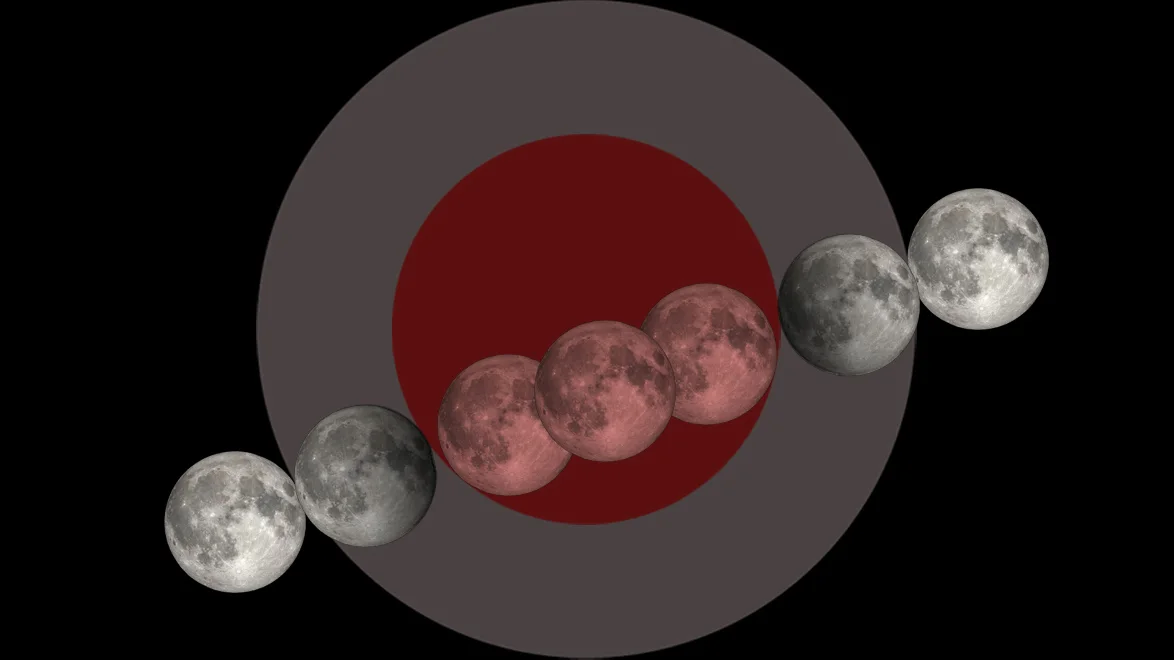
This spring, Canadians will see their longest total lunar eclipse in 15 years
Mark your calendars so you don't miss out on some great astronomical events.
Planetary alignments, meteor showers (including a potentially super-rare one), and a total lunar eclipse — there are astronomical sights to see every night this spring.
The nights may be growing shorter, but as the weather gradually warms up throughout the season, stargazing and night sky viewing becomes less of a challenge. There is plenty to see this spring, as well.
A collection of some of the brightest planets in our sky will be arrayed along the eastern horizon, just before sunrise, all season long. Added to that, there's the usual spring meteor showers — the Lyrids and the eta Aquariids — plus a potential bonus as the seldom-seen tau Herculids meteor shower may produce an extremely rare outburst. Also, be sure to clear your calendar for the night of May 15, so you can watch the Moon turn blood red during the longest total lunar eclipse seen from Canada since 2007.
Here's our complete guide to the astronomical events of Spring 2022.
March 20 — Equinox
March 20-31 — Mars, Venus, and Saturn, southeastern sky, pre-dawn
March 20 — Zodiacal Light after evening twilight, western sky for two weeks
March 27-29 — Crescent Moon joins Mars, Venus, and Saturn in pre-dawn sky
April 1-9 — Jupiter joins pre-dawn planetary lineup
April 4 — Mars and Saturn very close together
April 16-17 — Full Pink Moon
April 21-22 — Lyrid meteor shower peak
April 30 — Partial Solar Eclipse across SE Pacific and South America
May 4-5 — eta Aquariid meteor shower peak
May 16 — Full Flower Moon and Total Lunar Eclipse
May 31 — Potential rare outburst of tau Herculids meteor shower
June 14 — Super Strawberry Moon
June 21 — Solstice
Visit our Complete Guide to Spring 2022 for an in-depth look at the Spring Forecast, tips for planning for it and much more!
THE PLANETS
Early risers are in for a treat during this spring season.
If you are out in the hour or so just before sunrise, look to the southeast to see a cluster of planets arrayed along the horizon. To start, Venus, Mars, and Saturn will form a triangle that shifts, morning by morning.
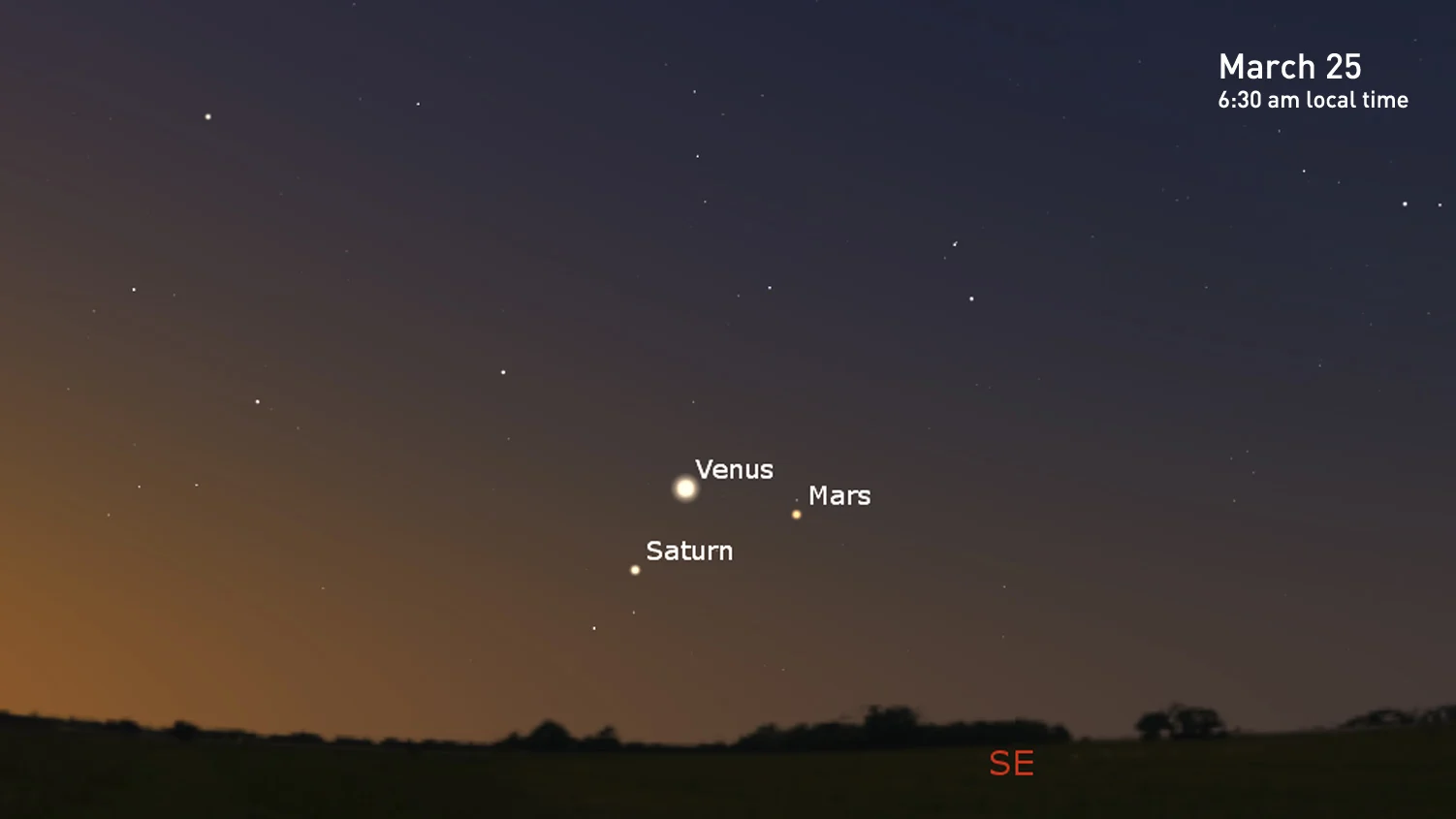
Venus, Mars, and Saturn form a triangle along the eastern horizon, pre-dawn, on March 25. Credit: Stellarium/Scott Sutherland
Watch for the Crescent Moon to swing by this trio from the 27th to the 29th of March.
In early April, Jupiter will pop up above the pre-dawn horizon, joining the other planets there just as Saturn and Mars approach for a close conjunction.

Jupiter joins Venus, Mars, and Saturn, as the Red Planet and the Ringed Planet swing closely past each other in our sky. Credit: Stellarium/Scott Sutherland
Keep watching throughout the rest of the season, as well. The positions of the planets will change and Venus will slip below the horizon, but this celestial lineup will continue to put on a show.
THE ZODIACAL LIGHT
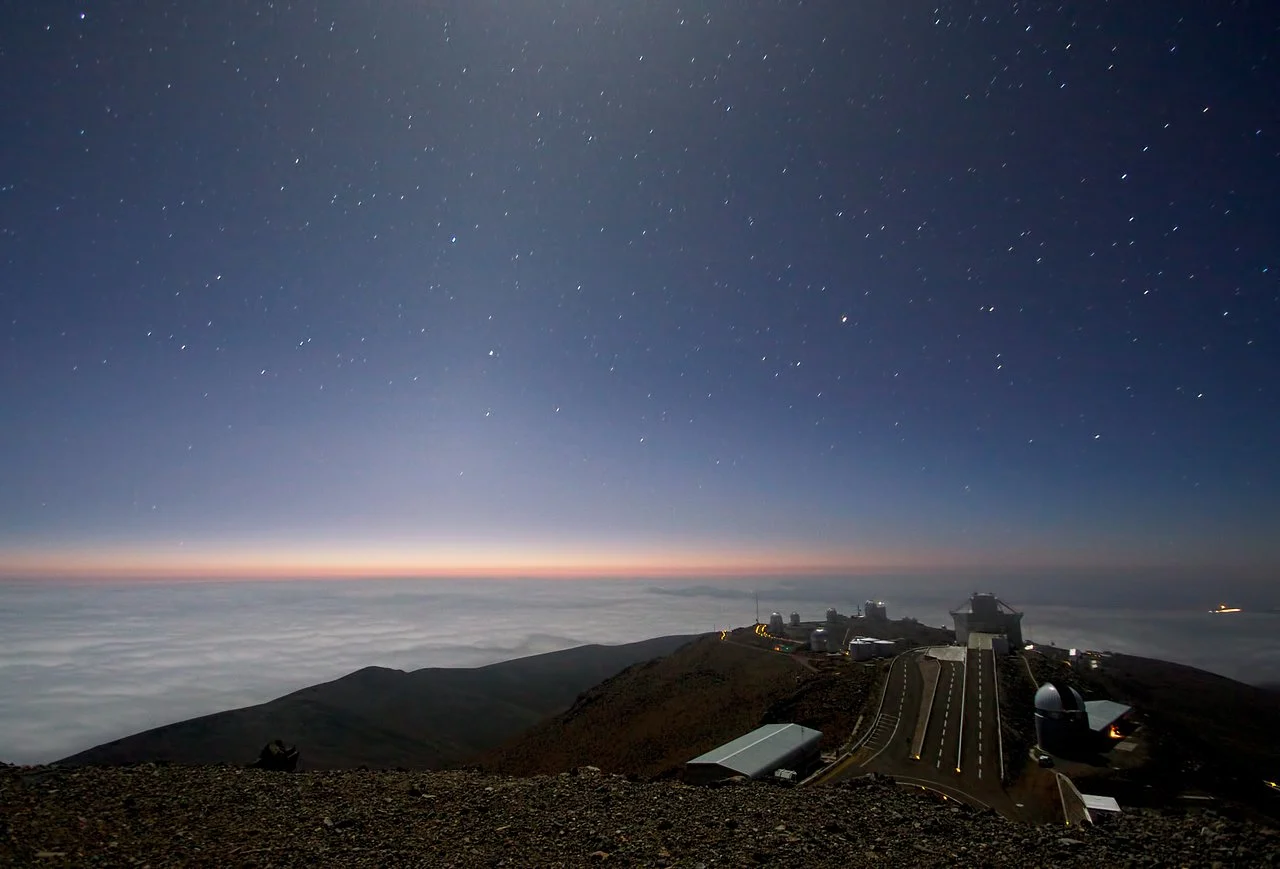
Moonlight and zodiacal light over La Silla. Credit: ESO
For about two weeks this spring, evening skywatchers can catch a glimpse of the immense cloud of interplanetary dust that encircles the Sun. This manifests in our night sky as the Zodiacal Light.
In the Royal Astronomical Society of Canada 2022 Observer's Handbook, Dr. Roy Bishop, Emeritus Professor of Physics from Acadia University, wrote: "The zodiacal light appears as a huge, softly radiant pyramid of white light with its base near the horizon and its axis centred on the zodiac (or better, the ecliptic). In its brightest parts, it exceeds the luminance of the central Milky Way."
According to Dr. Bishop, even though this phenomenon can be quite bright, it can easily be spoiled by moonlight, haze or light pollution. Also, since it is best viewed just after twilight, the inexperienced sometimes confuse it for twilight and miss out.
On clear nights and under dark skies, look to the western horizon, in the half an hour just after twilight has faded, from about March 20 to April 3.
LYRID METEOR SHOWER PEAK
On April 22, the annual Lyrid meteor shower reaches its peak.
Lyrid meteors can be spotted in the night sky anytime between April 14 to 30, streaming away from its 'radiant' point near the constellation Lyra (look for the bright star Vega to guide you). The best time to view the Lyrids, however, is on the three nights around its peak.
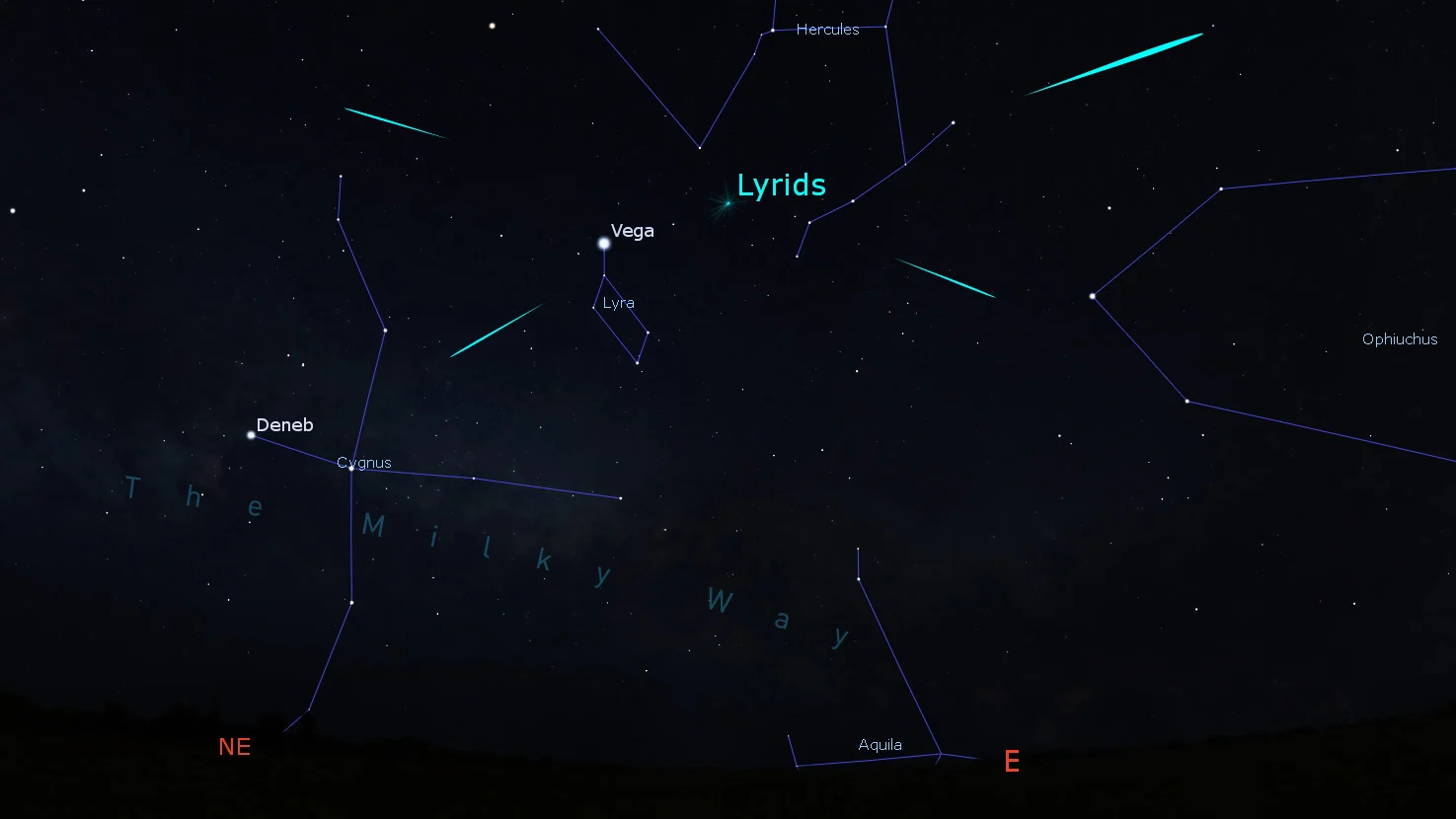
The radiant of the Lyrid meteor shower on the night of April 22, 2022, at around 1:30 a.m. local time. Credit: Stellarium/Scott Sutherland
This year, the peak occurs just a few days after the Full Moon. That means the waning gibbous Moon will add some light pollution to the sky, thus 'washing out' many of the dimmer meteors. Fortunately, the Moon will not be rising until after midnight, giving several hours of viewing time for anyone who wants to catch the event.
If you're still out early in the morning on April 23, take a break from meteor watching to look to the eastern horizon. There, you'll see a line up, with the crescent Moon joining four of the brightest planets in the sky.
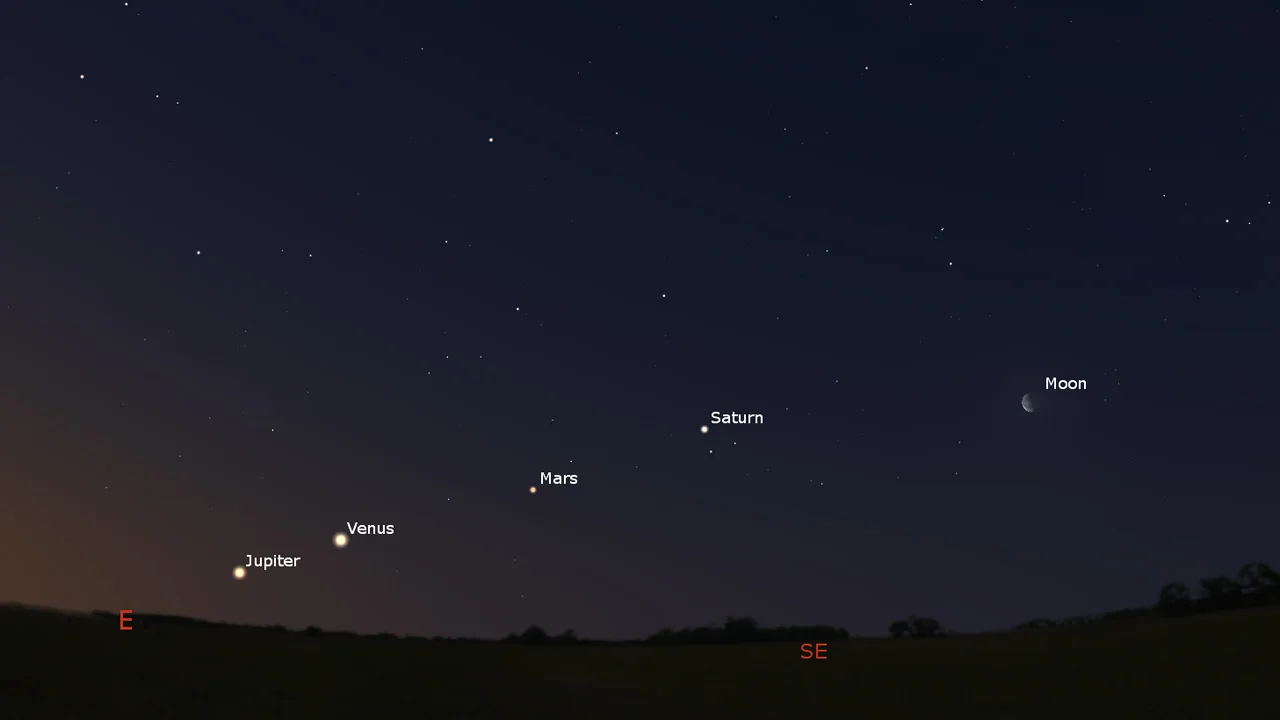
Jupiter, Venus, Saturn, and Mars form a line stretching along the horizon, with the crescent Moon joining them on the morning of April 23. Credit: Stellarium
Lyrid meteors originate from a stream of dusty, icy meteoroid debris left behind by Comet C/1861 G1 Thatcher. As Earth passes through this stream, the tiny meteoroids slam into the top of the atmosphere at speeds of around 100,000 km/h, turning the air in their path into white-hot plasma. This causes the meteor flash we see in the sky, which winks out either when the 'push-back' from the air sufficiently slows the meteoroid, or when the meteoroid completely vaporizes.
The stream of debris from Comet Thatcher is relatively sparse. Thus, even at the shower's peak, the Lyrids only deliver around 20 meteors per hour. Most viewers typically only see about half that number, and this year's timing with the Moon will reduce that even further.
Embedded within the comet's stream, however, is a smattering of slightly larger meteoroids. When those hit the atmosphere, they will produce bright fireballs!
The Lyrid radiant is up all night, so we can view this shower at any time after sunset (provided the weather is good). Be sure to get away from city light pollution to get the best show, and try to keep sources of light (even the Moon) out of your direct line of sight. More on this, below.
PARTIAL SOLAR ECLIPSE
Although there have been some amazing total and annular solar eclipses over the past few years, we are not quite as fortunate during 2022. We will have two partial solar eclipses, though, the first of which occurs on the 30th of April.
The whole event lasts for about 3 hours and 53 minutes, from 2:46 p.m. to 6:39 p.m. EDT on the 30th. The eclipse will reach its maximum at around 4:40 p.m. EDT, with just over 50 per cent of the Sun's disc covered by the Moon at that time.
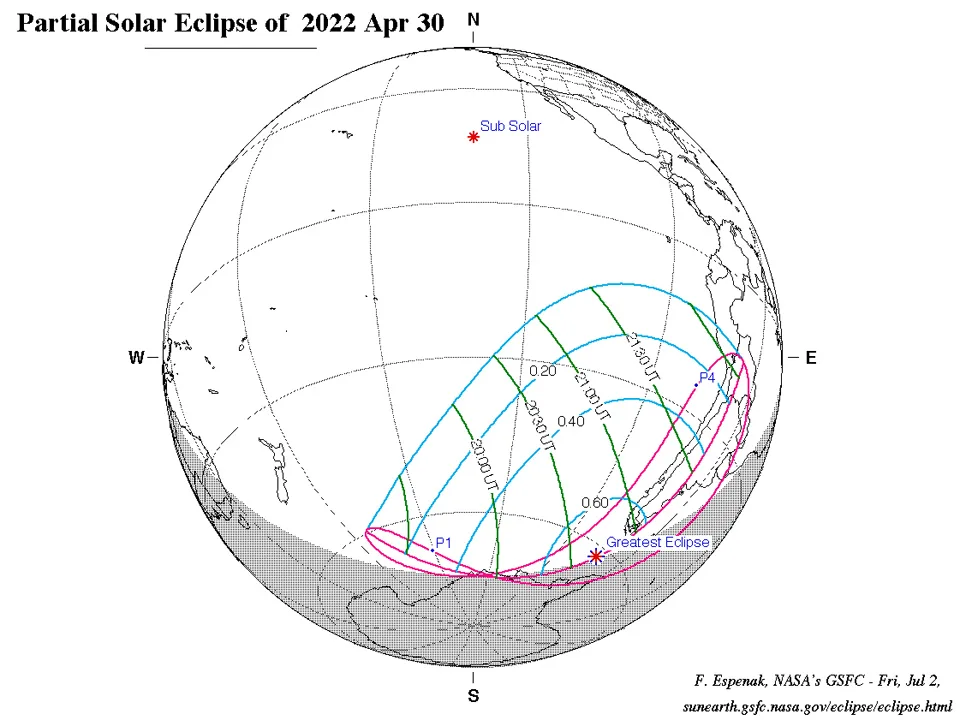
This graphic shows the path of the April 30 partial solar eclipse. Credit: NASA/Fred Espenak
As it will be visible only from the southeastern Pacific Ocean and southern parts of South America, we won't see it directly from Canada. However, given that the best viewing will be through Argentina, there's a good chance that someone will be broadcasting it, live, over the internet as it happens.
ETA AQUARIID METEOR SHOWER PEAK
We haven't seen Halley's Comet since 1986, and this most famous of comets won't show up in our skies again until 2061. Every year, though, we get two reminders of its existence. The first comes up as Earth passes through the "outbound" stream of meteoroids from the comet, producing the eta Aquariids meteor shower.
Active from around April 19 to May 28 each year, this meteor shower peaks on the night of May 4-5 in 2022.
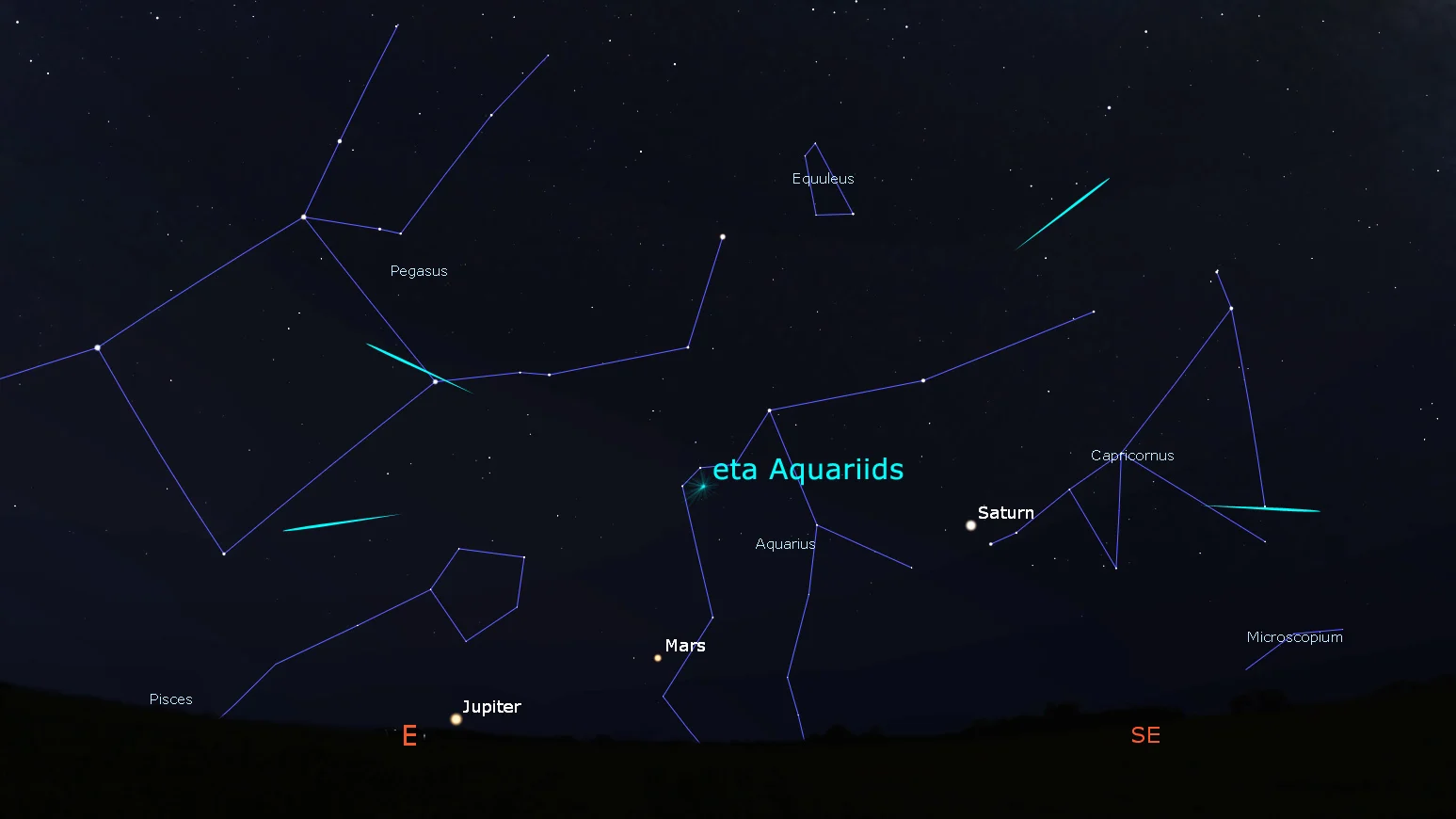
The radiant of the eta Aquariid meteor shower, at roughly 4:30 a.m. local time, on May 6. Credit: Stellarium/Scott Sutherland
The best time to see the eta Aquariids is in the hours before dawn on May 5, since the radiant only rises above the eastern horizon at that time. Also, with only a waning crescent Moon at the time, there is little competing light for the meteors.
The eta Aquariids typically produce around 50 meteors per hour under ideal conditions (clear, dark sky, with the meteor shower radiant directly overhead). Most observers will likely see a couple of dozen per hour, but possibly more depending on sky conditions. This shower does not tend to produce bright fireballs, as the Lyrids do. The meteoroids are moving so quickly when they hit our atmosphere, however, that they can produce a phenomenon called persistent trains.
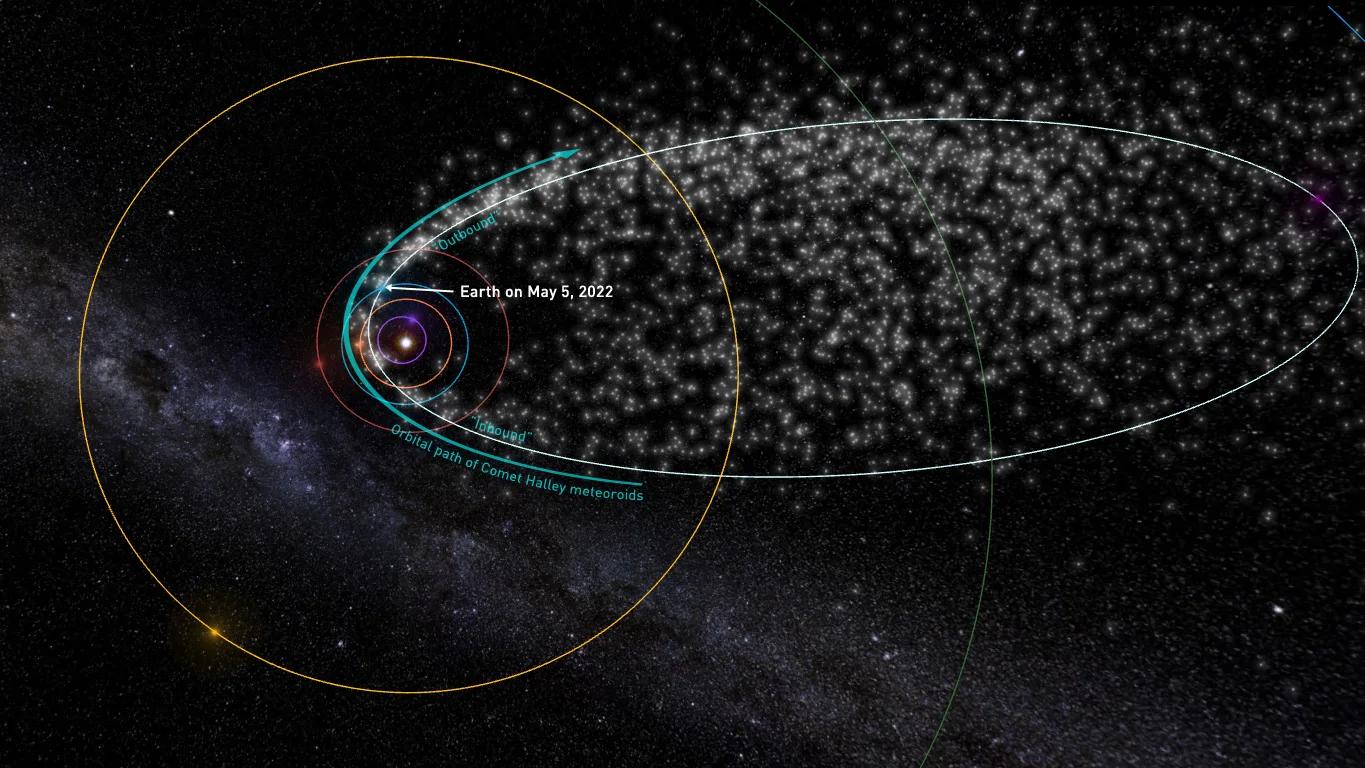
This graphic shows the orbit and debris stream of Comet Halley, noting the direction the stream is moving, with the "inbound" producing the October Orionids and the "outbound" resulting in the May eta Aquariids. Credit: meteorshowers.org/Scott Sutherland
When a typical cometary meteoroid hits the top of Earth's atmosphere, it moves fast enough to produce a meteor flash (as mentioned above). However, the particles in the eta Aquariid stream hit Earth's atmosphere travelling at nearly two and a half times as fast!
Streaking through the air at 240,000 km/h, Comet Halley meteoroids produce the usual brief meteor flash, but they can also result in a bonus. Once the meteor goes out, a glowing trail is left behind, floating in the air, called a persistent train. Some persistent trains last for minutes after the meteor flash, while others remain visible for hours.
Watch below to see a persistent train from a different meteor shower
Since persistent trains have only rarely been recorded, scientists still aren't quite sure what causes them. There are two possible explanations, though.
The first is that the meteoroids are travelling fast enough to strip electrons from the air molecules, leaving them in an ionized state. As the air molecules snatch up electrons from their surroundings, they release energy in the form of light. Since this process can take much longer than the original meteor flash, the 'train' appears fainter, and it can persist for some time after the meteor flash ends.
The other idea involves what is known as 'chemiluminescence'. Metals vaporizing off the fast-moving meteoroid's surface can chemically react with ozone and oxygen in the air to produce a glow.
One of these explanations may account for these 'trains', or both may cover different occurrences at different times and even between individual meteors. It will take more sightings of these to explain them fully.
TOTAL LUNAR ECLIPSE
Last year, in 2021, we witnessed two lunar eclipses shining in our skies. May's Super Blood Flower Moon was the last 'supermoon' total lunar eclipse that we'll see for the next decade. Then, in November, there was the 'almost total' lunar eclipse, where the Full Moon passed through Earth's shadow, but a tiny sliver of the lunar south pole remained outside of the dark umbra during the event. The result was the longest partial lunar eclipse in centuries!
This year, we are again seeing two lunar eclipses, and coincidentally, they are again occurring in May and November!
The first occurs on the night of May 15-16, as the Full Flower Moon passes through Earth's shadow. Unlike last year, however, this Full Moon isn't close enough to Earth to qualify as a 'supermoon'.
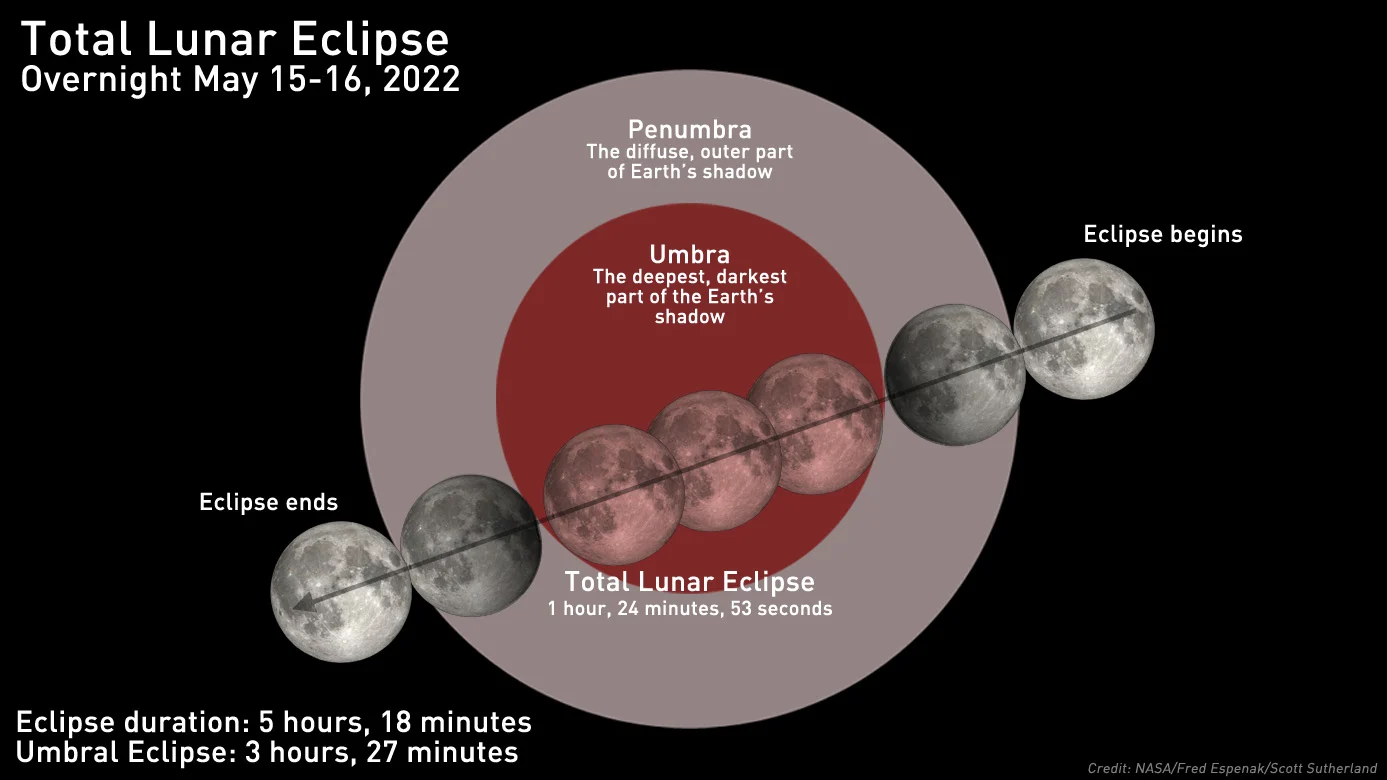
The path of the Full Flower Moon as it passes through Earth's shadow on the night of May 15-16, 2022. Credit: NASA/Fred Espenak/Scott Sutherland
While the eclipse begins at around 9:32 p.m. EDT on the night of the 15th, it will really become noticeable as the Moon begins its transit into the umbra, roughly an hour later. The dark shadow will slowly creep across the face of the Moon, so that by 11:29 p.m. EDT, it will be completely immersed, turning a dusky red colour. The eclipse will reach its maximum at 12:11 a.m. EDT, before it begins exiting the umbra at 1:53 a.m. EDT.
According to NASA, with the total eclipse lasting nearly an hour and 25 minutes, while there have been longer ones in more recent years, this will be the longest total lunar eclipse seen from Canada since 2007.
Viewers in Atlantic Canada, Quebec, and most of Ontario will see the entire event, from start to finish. The farther west you are, however, the farther along the eclipse will be in its timeline by the time the Moon rises.
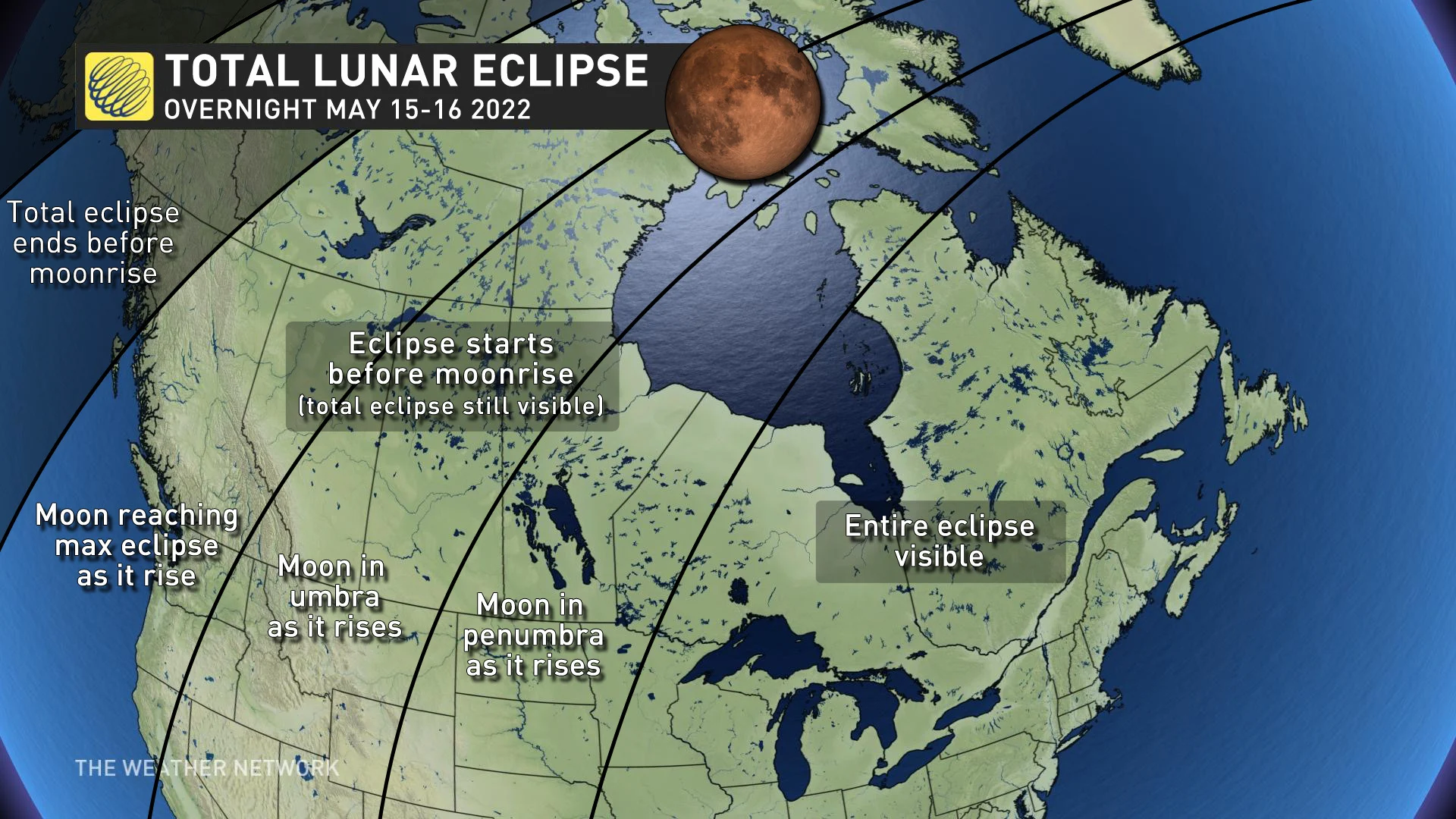
If you can't see it for yourself, the event is sure to be live-streamed from various locations across Canada and the United States. If you miss it entirely, don't fret. There's another chance (especially good for western Canada) coming up in early November.
RARE METEOR SHOWER OUTBURST?
Each year, between May 19 to June 19, there is a 'placeholder' on meteor calendars, marking the dates of the little-known and seldom-mentioned tau Herculids meteor shower.
The reason why it's little-known and seldom-mentioned? Although it was apparently quite the sight when it was first discovered in 1930, it is difficult to pin down any reliable reports of activity from the tau Herculids since then. In a 2006 study, meteor scientists at Western University, in London, ON, mentioned that "Modern activity from this stream is essentially non-existent."
However, based on what they know about the shower's source — fragmented Comet 73P/Schwassmann–Wachmann 3 — astronomers predict that we may actually see an outburst from this meteor shower in 2022.
With the comet set to make a close pass around the Sun in August of this year, the debris stream from it is expected to swing by Earth on May 31.
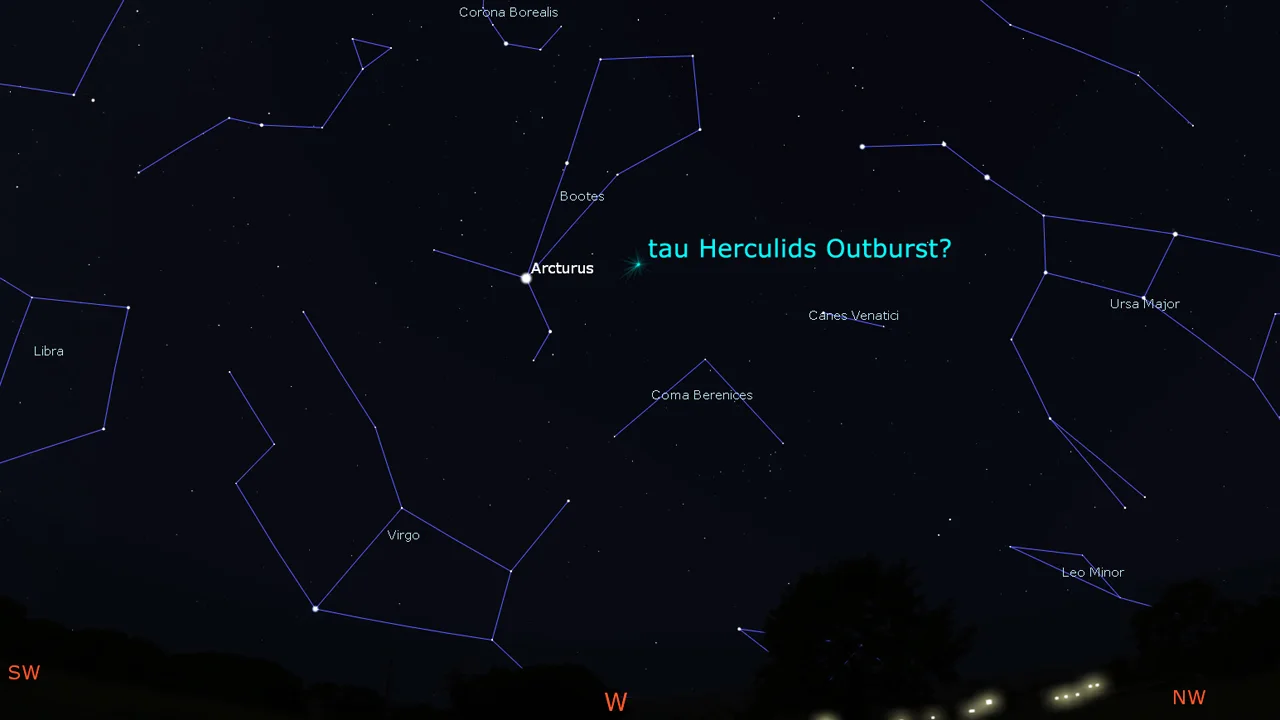
The location of the tau Herculids meteor shower radiant, high in the sky, on the night of May 31-June 1, 2022. Credit: Stellarium/Scott Sutherland
According to the International Meteor Organization (IMO), the shower will be best seen from parts of North America and throughout Central America, and optimally from southern California, Mexico, and Texas. However, it will be worth it for anyone with clear skies throughout North America to go have a look that night, just to see what might happen.
TIPS FOR STARGAZING AND METEOR SHOWERS
Given how polluted our night skies are with urban light, it is no longer a simple matter to step outside and gaze up at the stars. It's even more difficult to watch an event such as a meteor shower. Follow the tips below, though, and you won't miss out on these amazing events.
There are three best practices for observing the night sky:
Check the weather,
Get away from light pollution, and
Be patient.
Clear skies are essential. Even a few hours of cloudy skies can ruin your chances of watching an event such as a meteor shower. So, be sure to check The Weather Network on TV, on our website, or from our app, and look for my articles on our Space News page, just to be sure that you have the most up-to-date sky forecast.
Next, you need to get away from city light pollution. If you look up into the sky from home, what do you see? The Moon, a planet or two, perhaps a few bright stars such as Vega, Betelgeuse and Procyon, as well as some passing airliners? If so, there's too much light pollution in your area to get the most out of a meteor shower. You might catch an exceptionally bright fireball if one happens to fly past overhead, but that's likely all you'll see. So, to get the most out of your stargazing and meteor watching, get out of the city. The farther away you can get, the better.
Watch: What light pollution is doing to city views of the Milky Way
For most regions of Canada, getting out from under light pollution is simply a matter of driving outside of your city, town or village until a multitude of stars is visible above your head.
In some areas, especially in southern Ontario and along the St. Lawrence River, the concentration of light pollution is too high. Getting far enough outside of one city to escape its light pollution tends to put you under the light pollution dome of the next city over. The best options for getting away from light depend on your location. In southwestern Ontario and the Niagara Peninsula, the shores of Lake Erie can offer some excellent views. In the GTA and farther east, drive north and seek out the various Ontario provincial parks or Quebec provincial parks. Even if you're confined to the parking lot after hours, these are usually excellent locations from which to watch (and you don't run the risk of trespassing on someone's property).
If you can't get away, the suburbs can offer at least a slightly better view of the night sky. Here, the key is to limit the amount of direct light in your field of view. Dark backyards, sheltered from street lights by surrounding houses and trees, are your best haven. The video above provides a good example of viewing based on the concentration of light pollution in the sky. Also, check for dark sky preserves in your area.
When viewing a meteor shower, be mindful of the phase of the Moon. Meteor showers are typically at their best when viewed during the New Moon or Crescent Moon. However, a Gibbous or Full Moon can be bright enough to wash out all but the brightest meteors. Since we can't get away from the Moon, the best option is just to time your outing right, so the Moon has already set or is low in the sky. Also, you can angle your field of view to keep the Moon out of your direct line of sight. This will reduce its impact on your night vision and allow you to spot more meteors.
Once you've verified you have clear skies and you've limited your exposure to light pollution, this is where being patient comes in.
For best viewing, your eyes need some time to adapt to the dark. Give yourself at least 20 minutes, but 30-45 minutes is best for your eyes to adjust from being exposed to bright light.
Warning: This is possibly the one thing that causes the most disappointment when it comes to watching a meteor shower. Stepping out into the backyard from a brightly lit home and looking up for five minutes, you might be lucky enough to catch a rare bright fireball meteor. However, it's far more likely that you won't see anything at all. However, waiting for at least twenty minutes and avoiding sources of light during that time — streetlights, car headlights and interior lights, and smartphone and tablet screens — dramatically improves your chances of avoiding disappointment.
Sometimes, avoiding your smartphone or tablet isn't an option. In this case, set the display to reduce the amount of blue light it gives off and reduce the screen's brightness. That way, it will have less of an impact on your night vision.
You can certainly gaze into the starry sky while you are letting your eyes adjust. You may even see a few of the brighter meteors as your eyes become accustomed to the dark.
Once you're all set, just look straight up and enjoy the view!











